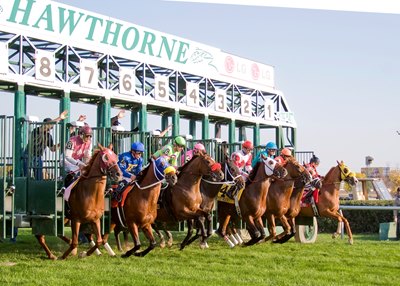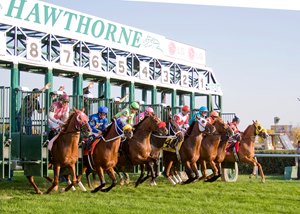Hawthorne Meeting Ran With No Catastrophic Breakdowns


Illinois horsemen and track officials announced July 6 the recently conducted meet at Hawthorne Race Course concluded without a single catastrophic breakdown in either racing or training, an accomplishment credited to maintenance of the racing surfaces, "vigilance" of backstretch workers, more turf racing, and new veterinary policies.
Training began in late March when the dirt surface was rebuilt after harness racing and continued through June 26 with 247 races and 1,648 starters. Hawthorne originally was awarded 32 dates for the meeting but, with approval from the Illinois Racing Board, vacated six of them, citing a shortage of available horses.
"This is the product of commitment and cooperation across our entire racing community at Hawthorne," said Hawthorne assistant general manager John Walsh. "The nation's eye is on safety in horse racing and we are thrilled that all our work to ensure the safety of horses racing at Hawthorne produced such a terrific outcome."
Chris Block, president of the Illinois Thoroughbred Horsemen's Association, noted Hawthorne, the sole remaining Chicago-area track, converted the dirt surface from harness to Thoroughbred configuration four times over the past year.
"It's a tall order for Hawthorne to convert the dirt track from harness to Thoroughbred, and then back, after each meet. Hawthorne had that track in good order and that's essential to safe racing," Block said. "The turf course was in fine condition, too, despite an extended dry spell during June."
Block also cited two additional factors.
"One, the state's veterinarian in July 2020 implemented a new policy under which a negative drug test is necessary for a horse to be removed from the vet's list and return to racing and, two, this meet at Hawthorne featured a greater percentage of turf races than at previous Hawthorne meets."
He said 18.6% of the races were on turf this spring and summer, while during the spring and fall of 2021 those figures were 11.7% and 10.6%, respectively.
"Competent trainers go to great lengths to protect our horses, following best practices on therapeutic medications, closely monitoring and evaluating workouts, studying all the indicators of a horse's health," Block said. "But we also recognize that, sadly, catastrophic breakdowns do occur in racing. To complete this meet without a single catastrophic breakdown is a tremendous relief and a testament to the vigilance of all of us racing together at Hawthorne."
The ITHA also noted overnight purses averaged $205,000 during this spring-summer meeting, while during previous Hawthorne meets they averaged $105,000 to $110,000. The increase was driven in large measure by fewer racing dates and increased "dark time" simulcast money now that Arlington International Racecourse is closed.
Horsemen still await an expected further influx of purse money from an on-track casino. Work on that project, however, has been stalled for a lengthy period without an explanation for the delay.
